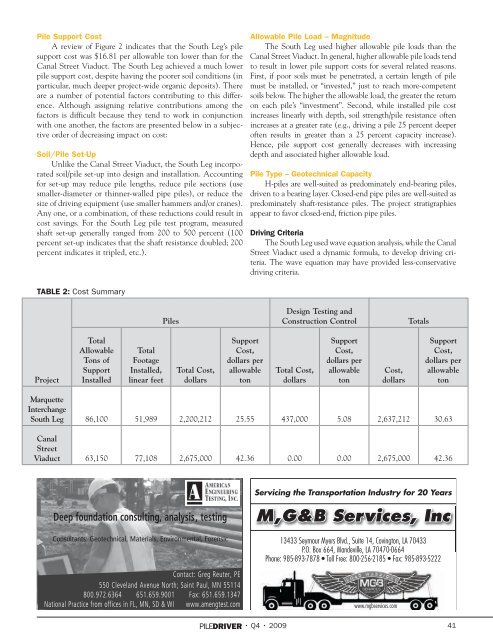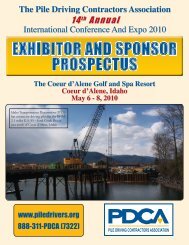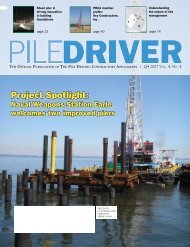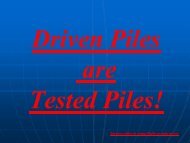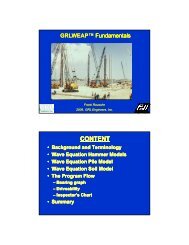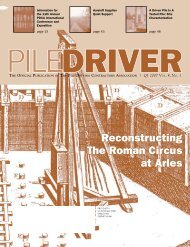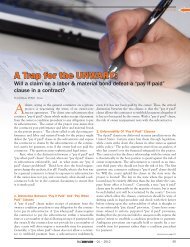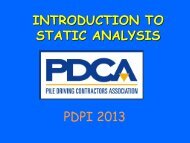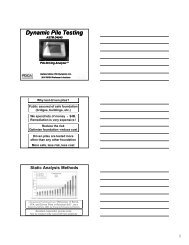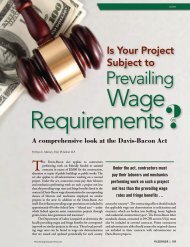Full Issue (17 MB) - Pile Driving Contractors Association
Full Issue (17 MB) - Pile Driving Contractors Association
Full Issue (17 MB) - Pile Driving Contractors Association
Create successful ePaper yourself
Turn your PDF publications into a flip-book with our unique Google optimized e-Paper software.
<strong>Pile</strong> Support Cost<br />
A review of Figure 2 indicates that the South Leg’s pile<br />
support cost was $16.81 per allowable ton lower than for the<br />
Canal Street Viaduct. The South Leg achieved a much lower<br />
pile support cost, despite having the poorer soil conditions (in<br />
particular, much deeper project-wide organic deposits). There<br />
are a number of potential factors contributing to this difference.<br />
Although assigning relative contributions among the<br />
factors is difficult because they tend to work in conjunction<br />
with one another, the factors are presented below in a subjective<br />
order of decreasing impact on cost:<br />
Soil/<strong>Pile</strong> Set-Up<br />
Unlike the Canal Street Viaduct, the South Leg incorporated<br />
soil/pile set-up into design and installation. Accounting<br />
for set-up may reduce pile lengths, reduce pile sections (use<br />
smaller-diameter or thinner-walled pipe piles), or reduce the<br />
size of driving equipment (use smaller hammers and/or cranes).<br />
Any one, or a combination, of these reductions could result in<br />
cost savings. For the South Leg pile test program, measured<br />
shaft set-up generally ranged from 200 to 500 percent (100<br />
percent set-up indicates that the shaft resistance doubled; 200<br />
percent indicates it tripled, etc.).<br />
Allowable <strong>Pile</strong> Load – Magnitude<br />
The South Leg used higher allowable pile loads than the<br />
Canal Street Viaduct. In general, higher allowable pile loads tend<br />
to result in lower pile support costs for several related reasons.<br />
First, if poor soils must be penetrated, a certain length of pile<br />
must be installed, or “invested,” just to reach more-competent<br />
soils below. The higher the allowable load, the greater the return<br />
on each pile’s “investment”. Second, while installed pile cost<br />
increases linearly with depth, soil strength/pile resistance often<br />
increases at a greater rate (e.g., driving a pile 25 percent deeper<br />
often results in greater than a 25 percent capacity increase).<br />
Hence, pile support cost generally decreases with increasing<br />
depth and associated higher allowable load.<br />
<strong>Pile</strong> Type – Geotechnical Capacity<br />
H-piles are well-suited as predominately end-bearing piles,<br />
driven to a bearing layer. Closed-end pipe piles are well-suited as<br />
predominately shaft-resistance piles. The project stratigraphies<br />
appear to favor closed-end, friction pipe piles.<br />
<strong>Driving</strong> Criteria<br />
The South Leg used wave equation analysis, while the Canal<br />
Street Viaduct used a dynamic formula, to develop driving criteria.<br />
The wave equation may have provided less-conservative<br />
driving criteria.<br />
TABLE 2: Cost Summary<br />
<strong>Pile</strong>s<br />
Design Testing and<br />
Construction Control<br />
Totals<br />
Project<br />
Total<br />
Allowable<br />
Tons of<br />
Support<br />
Installed<br />
Total<br />
Footage<br />
Installed,<br />
linear feet<br />
Total Cost,<br />
dollars<br />
Support<br />
Cost,<br />
dollars per<br />
allowable<br />
ton<br />
Total Cost,<br />
dollars<br />
Support<br />
Cost,<br />
dollars per<br />
allowable<br />
ton<br />
Cost,<br />
dollars<br />
Support<br />
Cost,<br />
dollars per<br />
allowable<br />
ton<br />
Marquette<br />
Interchange<br />
South Leg 86,100 51,989 2,200,212 25.55 437,000 5.08 2,637,212 30.63<br />
Canal<br />
Street<br />
Viaduct 63,150 77,108 2,675,000 42.36 0.00 0.00 2,675,000 42.36<br />
Servicing the Transportation Industry for 20 Years<br />
Deep foundation consulting, analysis, testing<br />
Consultants: Geotechnical, Materials, Environmental, Forensic<br />
Contact: Greg Reuter, PE<br />
550 Cleveland Avenue North; Saint Paul, MN 55114<br />
800.972.6364 651.659.9001 Fax: 651.659.1347<br />
National Practice from offices in FL, MN, SD & WI www.amengtest.com<br />
M,G&B Services, Inc<br />
13433 Seymour Myers Blvd., Suite 14, Covington, LA 70433<br />
P.O. Box 664, Mandeville, LA 70470-0664<br />
Phone: 985-893-7878 • Toll Free: 800-256-2185 • Fax: 985-893-5222<br />
www.mgbservices.com<br />
• Q4 • 2009<br />
41


